
We were fortunate to have been invited by Laura Adams to participate in the Cub Scout Pack 433 program to help the scouts with ” Collection Achievement” and ” Tools for Fixing and Building Achievement” aspects of their program. The scouts meet at the Sunset Elementary School, and we were the program for their January 14th meeting.
The program stared out explaining flight and demonstrating some indoor flight using a Peck Polymers Rocket Boy (Jetex powered), Sky Streak (Rubber Power), and a peanut scale rubber power model.
A Hobbico Avistar with a JR Radio system was used to show the Radio Control parts and operation.
Various tools from the flight kit were shown and discussed, including pliers, adjustable wrench, screwdrivers, and more. R/C specific items were also presented including a Quick Charger, ESV, glow plug wrench and starters. The scouts recognized most of these special items.
Safety was an element of every discussion. The scouts were shown how to fuel and de-fuel the Avistar using the flight kit’s fueling system. The poison symbol on the fuel jug was discussed, also.
The scouts got to see and handle various engines. These were part of Ron Swift’s engine collection, including:
- Zeus 0.61 CI Alcohol fuel Two Stroke from Russia
- Super Tigre 0.61 CI Alcohol fuel Two Stroke from Italy
- Enya 1.20 CI Alcohol fuel 4-stroke from Japan
- B 0.61 CI Alcohol fuel Two Stroke from Germany
- Modela CO2 free flight engine from Czechoslovakia
- Quadra 42 (2.52 CI) gasoline Two Stroke from Canada
- PAW 0.15 CI Diesel Fuel Two Stroke from England
- McCoy 0.35 CI Red Head Alcohol Fuel Two Stroke from USA
Following these discussions and hands on sessions, the Hobbico Avistar with its Saito 50 4-stroke engine were used to demonstrate safe engine starting.
Everyone seemed to enjoy the presentation. Each of the scouts was given their own Sky Streak kit (donated by the club). The kits were built and Laura helped the scouts learn to use a hammer and screwdriver to finish the requirements for one of the achievements. They were having lots of fun flying the planes outside the school.
This was the first part of a two part program. On Sunday, the scouts and families will visit Ron Swift’s shop to see more tools, planes, and if the weather cooperates, fly a plane using a buddy box system.

Ron is demonstrating the servo operation using the Avistar. The scouts were very interested in the model and asked some really good questions.

With the wing mounted on the fuselage, the plane was easier to see. Keeping clear of the propeller arc and always treating an engine as if it could start up at any moment were explained to the scouts. Again, safe operation was a theme that ran throughout the program.

Chuck Guy helped with starting the engine (it is running in this photo). For safety reasons Chuck held the model and all adjustments are made from behind the engine. The Avistar was taxied out a little ways and the engine shut off from the transmitter – again showing safety and R/C control.

Laura is helping teach the use of the hammer as one of the boys is readying his rubber powered Sky Streak for yet another flight. The boys trimmed their planes and were getting very long flight times outside.
Laura is helping teach the use of the hammer as one of the boys is readying his rubber powered Sky Streak for yet another flight. The boys trimmed their planes and were getting very long flight times outside.

The parents spent quality time with the scouts by taking the time to participate in the field trip. (The parents asked really good questions, too!)
Part of the presentation was a review of the shop power tools.

One of the shop tools (a collection of tools)demonstrated is the Oscillating Sander. We used this to grind a shape in a copper clad PC board. The PC boards are used for electronics and for servo horns. |

We marked the outline of a Hitec HS-77 low profile servo on the TuffFlight Predator wing. A soldering gun with a specially formed 14 gage wire was used to demonstrate foam cutting. The Predator is a Class B Open Combat plane. Seen in the background are some of the 60 or so models in the collection. Many of the planes were discussed, and a laser pointer was used (just for fun). Also, as part of the electronics collection, a Jacobs Ladder was demonstrated (showing how high voltage produces a spark, just like the gasoline engines do for ignition).

The scouts liked the peanut scale planes. These are some of the indoor free flight models in the collection.
| At the end of the presentation, Sandy served up brownies and lemonade. We all kept warm by standing near the wood stove. Once the snacks were eaten, a vote was taken whether or not they’d like to see one of the giant scale airplane run. (guess what the outcome of the vote was?! A 1/3 scale RV-3 model was fueled and started outside the shop. The model was taxied around the yard, showing ground handling and the scale engine sounds that the Saito 3.0 CI twin makes. The engine was shut off from the transmitter, following the safety practices we reviewed with the scouts. It is doubtful that all the questions were answered. As the event wound down, the scoutmaster asked if we could schedule another outing, where the scouts could watch the planes fly. I mentioned that the club would get together once again with the scouts and have them participate in our student pilot program! The scouts (and leaders too) can actually fly one of the models. We have invited them out for a flying field trip on Sunday, June 2 at 11:00 AM. It was a fun and learning experience for all! Thanks again to the scouts, for allowing us to share some of our knowledge and enthusiasm for this great hobby/sport! |
| The third part of the event was hands-on flying of the R/C models. We had 14 student pilots fly at the Barnyard Buzzards’ flying field on June 2. The photos tell the story… |
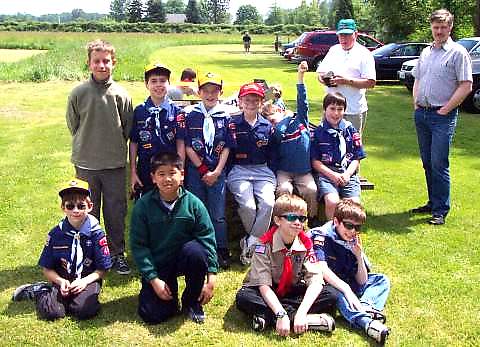
Here are the scouts with Hap, who was the ground school instructor. He conducted some teaching activities that kept the interest of kids (and adults).
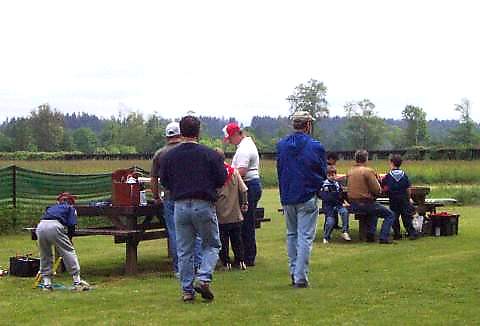
At the start of the day, we were busy getting the planes ready. Rick had a Zagi and his stick trainer, Hap brought his electric Military Cub (L1 Birddog), Brian had a nice pattern ship, Ron brought a AirMaster 40 trainer, Fantrainer, Big Eliminator, and the Ultrastick 40.
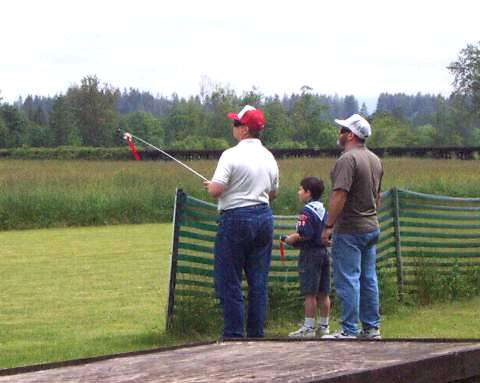
Rick piloted his trainer as Ron helped the younger pilots get familiar with the buddy box. Most student pilots flew really well considering this was their first experience. Each pilot got to learn to loop the plane and hold altitude in right and left turns.

Here’s Hap keeping the kids busy with the electric motor lab, while others take their turns at the sticks.

We had two student pilots at a time at the flight line and usually could have three pilots per tank of fuel. This gave each student about 4 minutes on the sticks.

The morning started out with overcast skies and almost no wind, but by late morning, the clouds had broken up, and the day was spectacular! The wind remained very calm. We actually had a few hawks and a deer visit with us during the event.

And still we flew! Rick put in a lot of patience and many flights. He helped make the student pilots feel good about their accomplishments on the sticks.

Sandy was our chef and put on quite a good lunch for all the attendees. We had soda, hotdog’s, hamburgers and cheese burgers for all. There wasn’t much food left, which is a good indication of her talents on the grill. (She also took the other photos on this web page!)

One of many landings Rick made during the event. Rick would fuel up the trainer, take it off to a safe height and talk the students through the lessons. He would correct the attitude of the model as needed and explain what the model did and how to correct the situation.
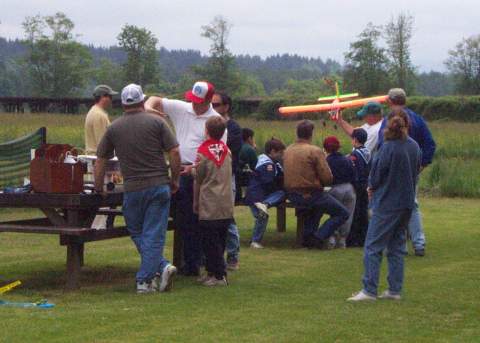
And Hap was still entertaining the student pilots who had already flown or were waiting for their turn.
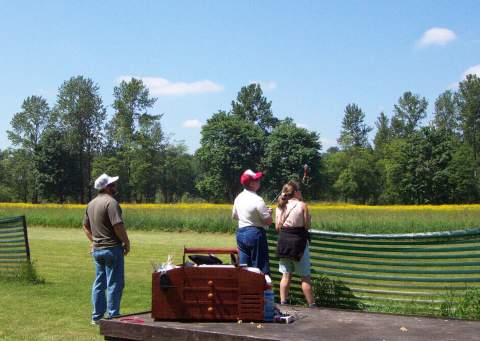
After lunch, some of the scout leaders and parents tried their hand at controlling the model. They were quite good and learned quickly.
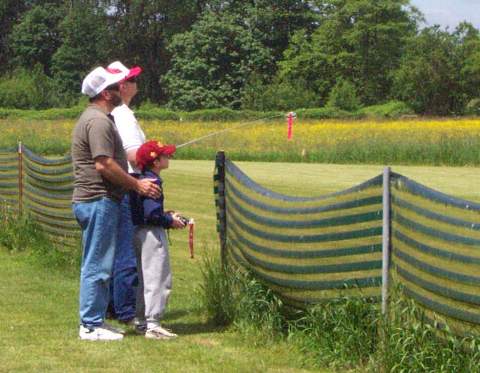
Yep, it couldn’t get much better than this. Although each of the student pilots came to realize it was a little tougher to fly one of these models than it first looked, they came away from the flight line with a smile and a sense of accomplishment. We enjoyed the day too!